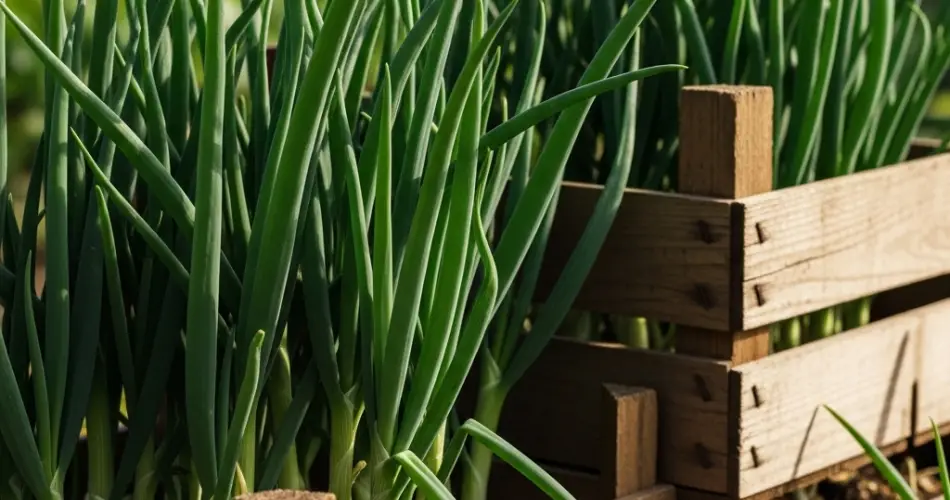If you love the fresh, mild bite of green onions (also known as scallions), why not grow your own right at home? These versatile, fast-growing plants don’t need a garden plot to thrive. In fact, a simple wooden crate is all it takes to grow crisp, flavorful green onions in your backyard—even in limited space.
Crate gardening is an easy, eco-friendly way to start growing your own produce. Green onions are particularly well-suited to container gardening because they don’t need much root depth, grow quickly, and can be harvested again and again.
Here’s how to build and maintain a backyard crate bed for green onions that produces fresh flavor all season long.
Why Grow Green Onions in Crates?
Wooden crates make great planting containers for a number of reasons:
-
Space-saving: Ideal for patios, decks, small yards, or balconies.
-
Excellent drainage: Crates naturally allow excess water to escape, helping to prevent root rot.
-
Portable: You can move your crate to chase sunlight or protect from extreme weather.
-
Recyclable and affordable: Old produce crates can be reused, making this a low-cost gardening solution.
Green onions are shallow-rooted and compact, making them perfect for growing in crates that might be too small for other vegetables.
What You’ll Need
To get started, gather the following materials:
-
A wooden crate (preferably 8–10 inches deep)
-
Landscape fabric, burlap, or old cloth (for lining)
-
Potting soil
-
Compost or aged manure
-
Perlite or sand (for improved drainage)
-
Green onion seeds, sets, or seedlings
-
Optional: mulch (like straw or shredded leaves)
Avoid crates treated with chemicals—choose untreated or food-safe wood, especially for edible crops.
Preparing Your Crate Bed
-
Line your crate: Use landscape fabric or burlap to line the inside. This holds the soil in place while still allowing water to drain.
-
Ensure drainage: If the crate has a solid bottom, drill a few holes to improve water flow.
-
Raise it up: Place the crate on bricks or wooden slats to prevent waterlogging and increase air circulation under the container.
-
Choose the location: Green onions prefer full sun but will tolerate partial shade. Place your crate in a spot that receives at least 5–6 hours of sunlight a day.
Mixing the Right Soil
Green onions thrive in loose, nutrient-rich, well-draining soil. Create your mix using:
-
2 parts quality potting soil
-
1 part compost or aged manure
-
A handful of perlite or sand to enhance drainage
Mix thoroughly, then fill the crate, leaving about an inch at the top for watering.
Planting Green Onions
You can grow green onions in three main ways:
-
Seeds: Sow directly into the soil about ¼ inch deep and 1 inch apart.
-
Sets: Small, immature onion bulbs that establish quickly. Push each set into the soil so the tip is just above the surface.
-
Transplants or store-bought scraps: Replant the white root ends of used green onions. Place them root-down in the soil and cover lightly.
For ongoing harvests, plant in staggered rows or every 2–3 weeks to maintain a steady supply.
Watering and Fertilizing
Green onions prefer evenly moist soil—don’t let it dry out completely.
-
Water regularly, especially during warm or windy weather.
-
Avoid soaking the foliage; focus on watering at the base of the plants.
Fertilize every 2–3 weeks with compost tea or a balanced liquid fertilizer. Because green onions grow quickly, light feeding is usually enough, especially if you started with compost-rich soil.
Maintenance Tips
Green onions are low-maintenance, but a little attention helps them thrive:
-
Weeding: Keep the crate bed weed-free to reduce competition.
-
Mulching: Apply a thin layer of organic mulch to retain moisture and suppress weeds.
-
Pest watch: Onions are naturally pest-resistant, but watch for thrips or aphids. Spray with soapy water or neem oil if needed.
-
Thinning: If you started from seed and the seedlings are too close together, thin them out to about 1–2 inches apart.
Harvesting Green Onions
Green onions are ready to harvest 30–60 days after planting, depending on the method and weather.
-
Harvest when the green tops are 6–10 inches tall and the white stems are pencil-thick.
-
Pull gently from the soil or snip at the base and leave the roots to regrow.
-
For continuous harvests, cut individual stalks and let the rest keep growing.
You can harvest multiple times from the same plant if you don’t pull it out completely.
Reusing the Crate
After harvesting, refresh the soil with more compost or rotate with another crop such as herbs or leafy greens. With proper care, a wooden crate can last for several seasons and support a wide range of vegetables throughout the year.
Final Thoughts
Green onions are one of the easiest crops to grow in a backyard crate bed. They require little space, grow fast, and provide a flavorful harvest that’s useful in almost any dish. Whether you’re an experienced gardener or just starting out, crate gardening offers a simple, satisfying way to enjoy homegrown produce.
So grab a wooden crate, a bit of soil, and some onion starts—and you’ll be harvesting your own crisp, fresh green onions in no time.



